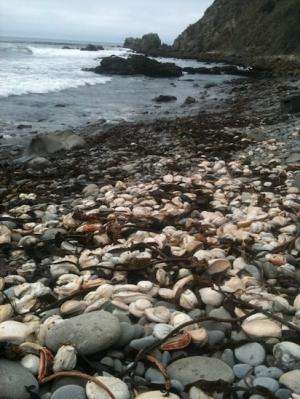Scientists solve the case of the red abalone die-off using forensic genomics

(Phys.org) —In August 2011, thousands of dead red abalone washed up on the beaches of Sonoma County in Northern California. At the time, the cause was unknown, but scientists, including a biologist from the University of California, Davis, learned that a harmful algal bloom was to blame: the causative agent Yessotoxin.
While discovery of the cause itself is noteworthy, the method by which it was determined could have a profound effect on how wildlife mortality events are investigated in the future. Described in a study published today, April 16, in the journal Nature Communications, the researchers call this new approach "forensic genomics." It involves a combination of field surveys, toxin testing and genomic scans.
In the case of red abalone, the finding was the result of fortunate timing.
"Just months before the mortality event, we had sequenced the entire genome of several red abalone in the same area," said co-author Laura Rogers-Bennett, a senior environmental scientist with the California Department of Fish and Wildlife working at the UC Davis Bodega Marine Laboratory. "What we had, in essence, was a baseline, so we went back to the same site after the mortalities and did a whole genome scan of the survivors."
With both sets of data in hand, they compared the two groups using a computer program and found a set of clues that pointed them in a very specific direction.
"Parts of the genome were significantly different than what you'd expect by chance," said Rogers-Bennett, an affiliated faculty member of the Karen C. Drayer Wildlife Health Center at UC Davis.
When they investigated those outliers, they found that their function was to aid in detoxification. The results supported their hypothesis that a harmful algal bloom producing a Yessotoxin was the major cause of the mass mortality rather than exposure to other potential toxins.
"Our technique has widespread applicability and could be useful in finding the causes of other wildlife mortality events," said Rogers-Bennett. "We never would have been able to do this if we hadn't done this whole scan of the entire genome in advance."
The findings demonstrate the value of gathering baseline genetics information about wild populations before a mortality event occurs, even if the baseline samples remain in a freezer until an event emerges.
More information: "Forensic genomics as a novel tool for identifying the causes of mass mortality events." Pierre De Wit, Laura Rogers-Bennett, Raphael M. Kudela, Stephen R. Palumbi. Nature Communications 5, Article number: 3652 DOI: 10.1038/ncomms4652. Received 05 September 2013 Accepted 14 March 2014 Published 16 April 2014
Journal information: Nature Communications
Provided by UC Davis















